2023 TOYOTA YARIS CROSS seats
[x] Cancel search: seatsPage 165 of 698
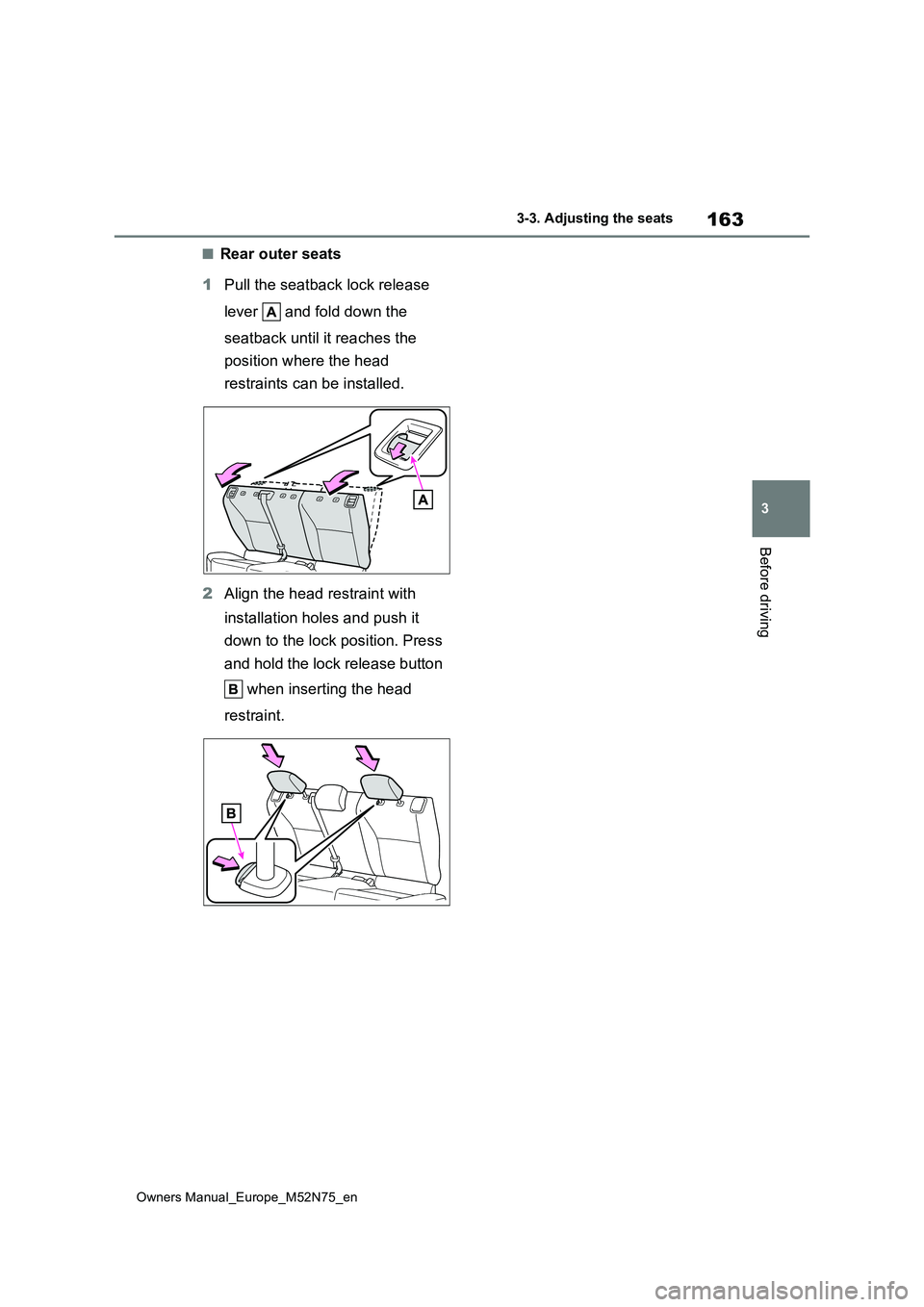
163
3
Owners Manual_Europe_M52N75_en
3-3. Adjusting the seats
Before driving
■Rear outer seats
1 Pull the seatback lock release
lever and fold down the
seatback until it reaches the
position where the head
restraints can be installed.
2 Align the head restraint with
installation holes and push it
down to the lock position. Press
and hold the lock release button
when inserting the head
restraint.
Page 183 of 698

181
4
Owners Manual_Europe_M52N75_en
4-1. Before driving
Driving
output may be restrained.
When the shift lever is shifted to
R*.
When the shift lever is shifted
from P or R to forward drive shift
position such as D*.
When the system operates, a mes-
sage appears on the multi-informa-
tion display. Read the message and
follow the instruction.
*: Depending on the situation, the shift
position may not be changed.
■Drive-Start Control (DSC)
When the TRC is turned off ( P.329), sudden start restraint control also does not operate. If your vehicle have trouble
escaping from the mud or fresh snow due to sudden start restraint control operation, deactivate TRC ( P.329) so
that the vehicle may become able to escape from the mud or fresh snow.
Also, sudden start restraint control will
not operate in the following conditions:
●When Trail Mode is turned on
Cargo and luggage
Take notice of the following
information about storage pre-
cautions, cargo capacity and
load:
WARNING
■Things that must not be carried in the luggage compartment
The following things may cause a fire if loaded in the luggage compartment:
●Receptacles containing gasoline
●Aerosol cans
■Storage precautions
Observe the following precautions.
Failure to do so may prevent the ped- als from being depressed properly, may block the driver’s vision, or may
result in items hitting the driver or passengers, possibly causing an acci-dent.
●Stow cargo and luggage in the lug-gage compartment whenever pos-
sible.
●Do not stack cargo and luggage in
the luggage compartment higher than the seatbacks.
●When you fold down the rear seats, long items should not be placed directly behind the front seats.
●Do not place cargo or luggage in or on the following locations.
• At the feet of the driver
• On the front passenger or rear seats (when stacking items)
• On the luggage cover
• On the instrument panel
• On the dashboard
Page 184 of 698

182
Owners Manual_Europe_M52N75_en
4-1. Before driving
WARNING
●Secure all items in the occupant compartment.
●Never allow anyone to ride in the luggage compartment. It is not
designed for passengers. They should ride in their seats with their seat belts properly fastened.
■Load and distribution
●Do not overload your vehicle.
●Do not apply loads unevenly.Improper loading may cause deteri-
oration of steering or braking con- trol which may cause death or serious injury.
■When loading cargo on the roof luggage carrier (if equipped)
Observe the following precautions:
●Place the cargo so that its weight is distributed evenly between the front
and rear axles.
●If loading long or wide cargo, never
exceed the vehicle overall length or width. ( P.484)
●Before driving, make sure the cargo is securely fastened on the roof lug-gage carrier.
●Loading cargo on the roof luggage carrier will make the center of grav-
ity of the vehicle higher. Avoid high speeds, sudden starts, sharp turns, sudden braking or abrupt maneu-
vers, otherwise it may result in loss of control or vehicle rollover due to failure to operate this vehicle cor-
rectly and result in death or serious injury.
●If driving for a long distance, on rough roads, or at high speeds, stop the vehicle now and then
during the trip to make sure the cargo remains in its place.
●Do not exceed 60 kg (132.3 lb.) cargo weight on the roof luggage carrier.
Page 211 of 698
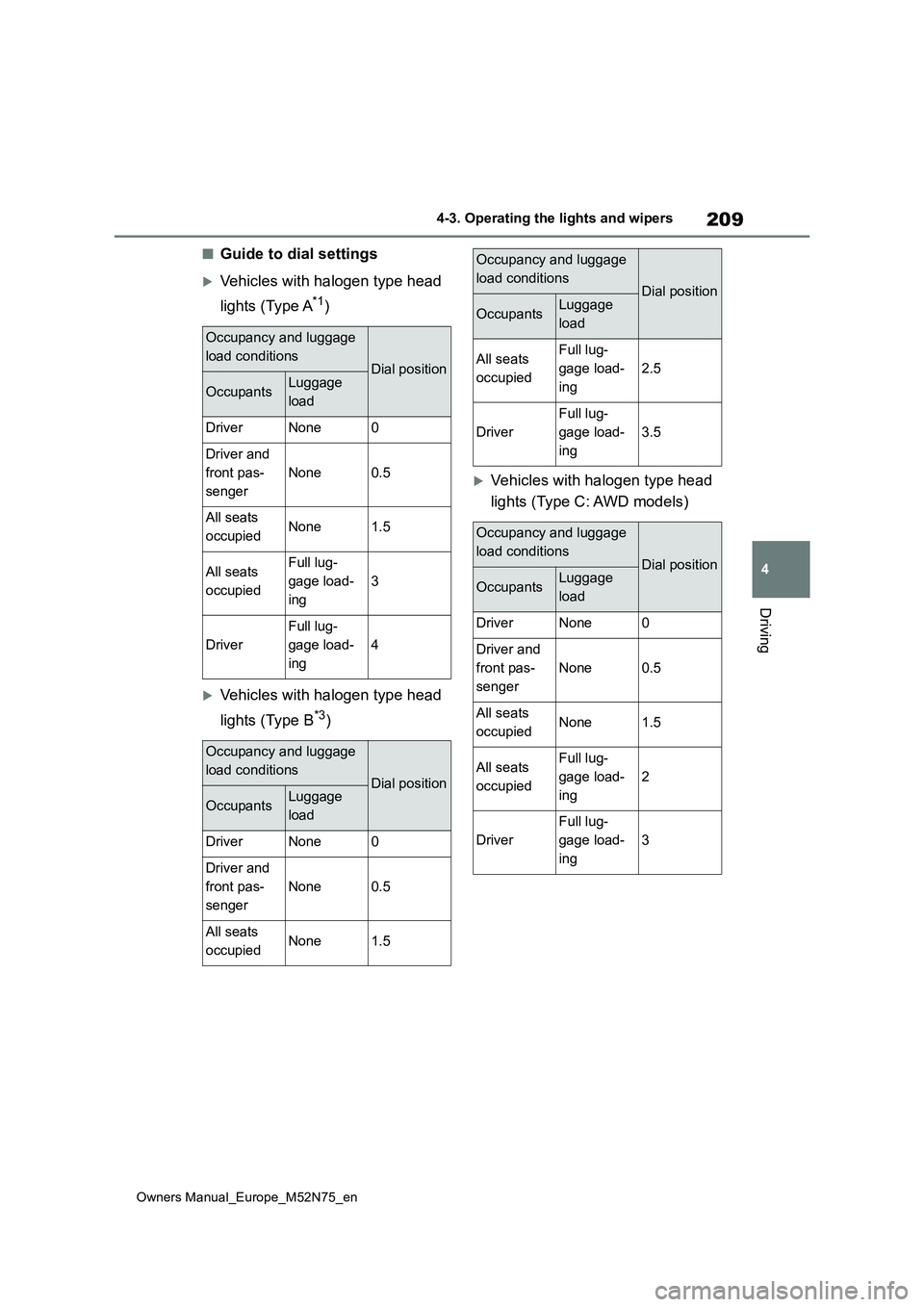
209
4
Owners Manual_Europe_M52N75_en
4-3. Operating the lights and wipers
Driving
■Guide to dial settings
Vehicles with halogen type head
lights (Type A*1)
Vehicles with halogen type head
lights (Type B*3)
Vehicles with halogen type head
lights (Type C: AWD models)
Occupancy and luggage
load conditionsDial position
OccupantsLuggage
load
DriverNone0
Driver and
front pas-
senger
None0.5
All seats
occupiedNone1.5
All seats
occupied
Full lug-
gage load-
ing
3
Driver
Full lug-
gage load-
ing
4
Occupancy and luggage
load conditionsDial position
OccupantsLuggage
load
DriverNone0
Driver and
front pas-
senger
None0.5
All seats
occupiedNone1.5
All seats
occupied
Full lug-
gage load-
ing
2.5
Driver
Full lug-
gage load-
ing
3.5
Occupancy and luggage
load conditionsDial position
OccupantsLuggage
load
DriverNone0
Driver and
front pas-
senger
None0.5
All seats
occupiedNone1.5
All seats
occupied
Full lug-
gage load-
ing
2
Driver
Full lug-
gage load-
ing
3
Occupancy and luggage
load conditionsDial position
OccupantsLuggage
load
Page 212 of 698
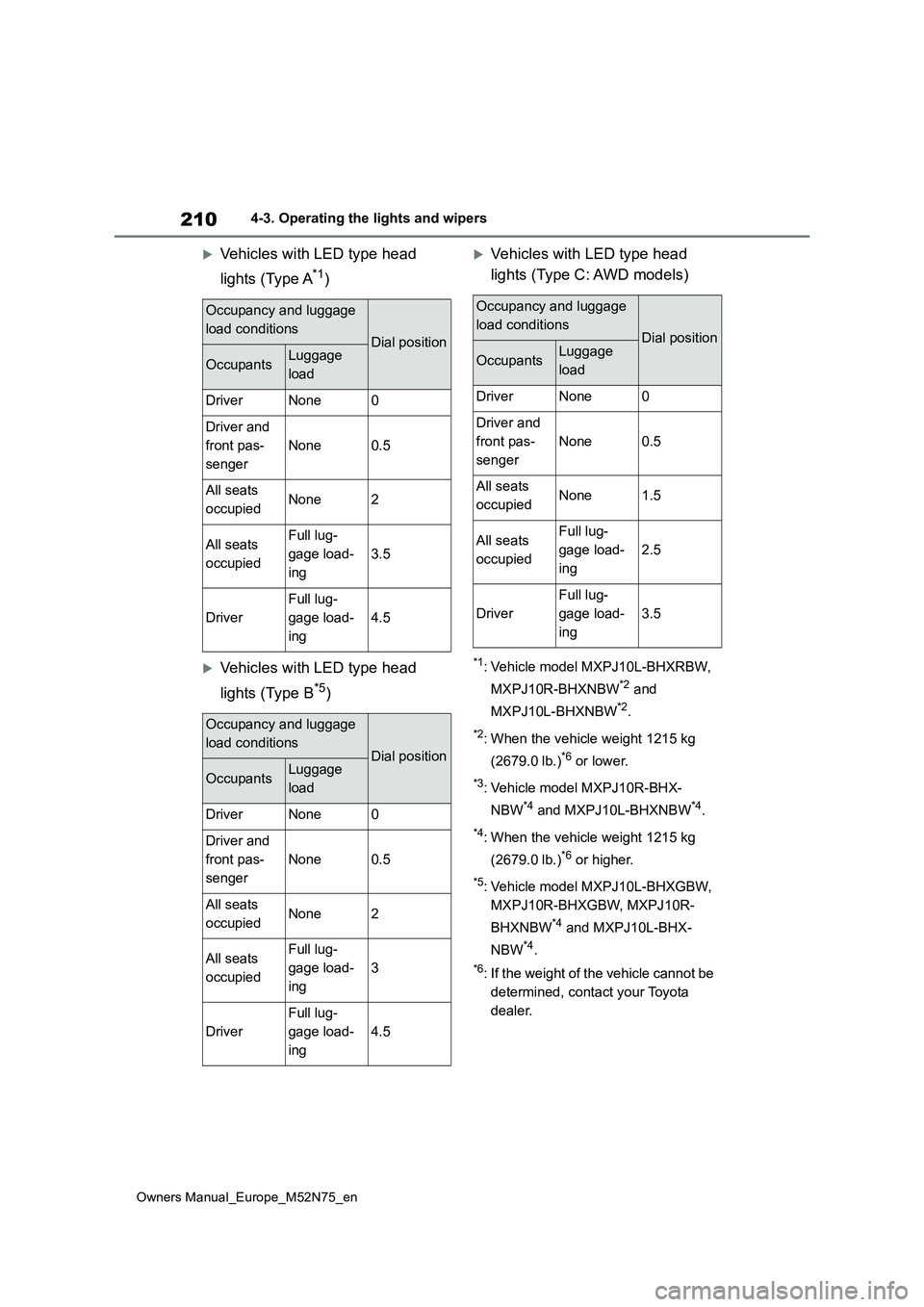
210
Owners Manual_Europe_M52N75_en
4-3. Operating the lights and wipers
Vehicles with LED type head
lights (Type A*1)
Vehicles with LED type head
lights (Type B*5)
Vehicles with LED type head
lights (Type C: AWD models)
*1: Vehicle model MXPJ10L-BHXRBW,
MXPJ10R-BHXNBW*2 and
MXPJ10L-BHXNBW*2.
*2: When the vehicle weight 1215 kg
(2679.0 lb.)*6 or lower.
*3: Vehicle model MXPJ10R-BHX-
NBW*4 and MXPJ10L-BHXNBW*4.
*4: When the vehicle weight 1215 kg
(2679.0 lb.)*6 or higher.
*5: Vehicle model MXPJ10L-BHXGBW,
MXPJ10R-BHXGBW, MXPJ10R-
BHXNBW*4 and MXPJ10L-BHX-
NBW*4.
*6: If the weight of the vehicle cannot be
determined, contact your Toyota
dealer.
Occupancy and luggage
load conditionsDial position
OccupantsLuggage
load
DriverNone0
Driver and
front pas-
senger
None0.5
All seats
occupiedNone2
All seats
occupied
Full lug-
gage load-
ing
3.5
Driver
Full lug-
gage load-
ing
4.5
Occupancy and luggage
load conditionsDial position
OccupantsLuggage
load
DriverNone0
Driver and
front pas-
senger
None0.5
All seats
occupiedNone2
All seats
occupied
Full lug-
gage load-
ing
3
Driver
Full lug-
gage load-
ing
4.5
Occupancy and luggage
load conditionsDial position
OccupantsLuggage
load
DriverNone0
Driver and
front pas-
senger
None0.5
All seats
occupiedNone1.5
All seats
occupied
Full lug-
gage load-
ing
2.5
Driver
Full lug-
gage load-
ing
3.5
Page 350 of 698

348
Owners Manual_Europe_M52N75_en
5-1. Using the air conditioning system and defogger
■Adjusting the position of and
opening and closing the air
outlets
Direct air flow to the left or right, up
or down
Center outlets: Move the knob fully to
the left-side to close the vent.
Side outlets: Move the knob fully to the
outside to close the vent.
*: If equipped
WARNING
■To prevent the windshield defog- ger from operating improperly
Do not place anything on the instru- ment panel which may cover the air outlets. Otherwise, air flow may be
obstructed, preventing the windshield defoggers from defogging.
Heated steering
wheel*/seat heaters*
Heated steering wheel
Warms up the grip of the steering
wheel
Seat heaters
Warm up the seat upholstery
WARNING
■To prevent minor burn injuries
Care should be taken if anyone in the following categories comes in contact with the steering wheel or seats when
the heater is on:
●Babies, small children, the elderly,
the sick and the physically chal- lenged
●Persons with sensitive skin
●Persons who are fatigued
●Persons who have taken alcohol or
drugs that induce sleep (sleeping drugs, cold remedies, etc.)
NOTICE
■To prevent damage to the seat heaters
Do not put heavy objects that have an
uneven surface on the seat and do not stick sharp objects (needles, nails, etc.) into the seat.
■To prevent 12-volt battery dis-charge
Do not use the functions when the hybrid system is off.
Page 374 of 698
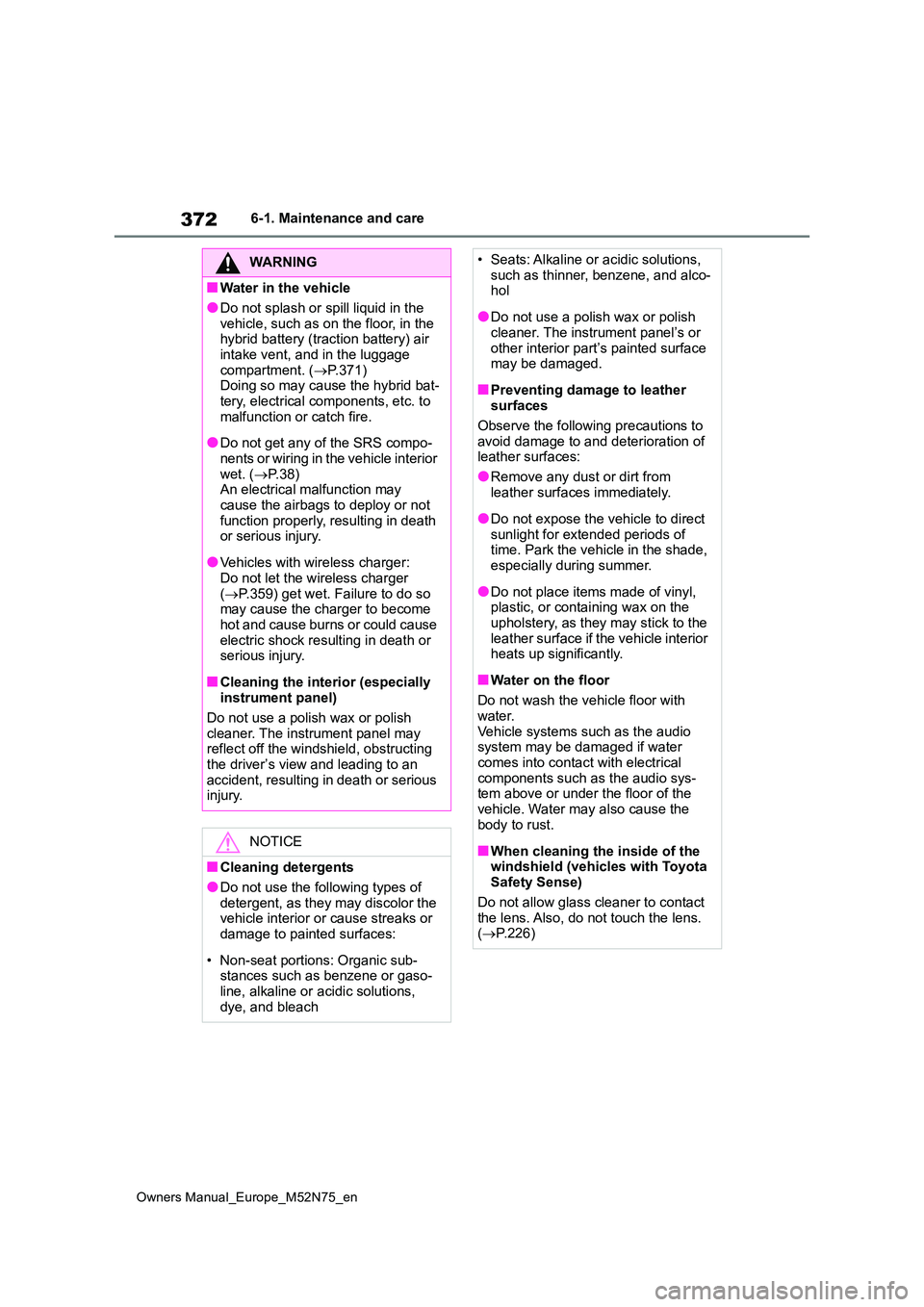
372
Owners Manual_Europe_M52N75_en
6-1. Maintenance and care
WARNING
■Water in the vehicle
●Do not splash or spill liquid in the
vehicle, such as on the floor, in the hybrid battery (traction battery) air intake vent, and in the luggage
compartment. ( P.371) Doing so may cause the hybrid bat-tery, electrical components, etc. to
malfunction or catch fire.
●Do not get any of the SRS compo-
nents or wiring in the vehicle interior wet. ( P. 3 8 ) An electrical malfunction may
cause the airbags to deploy or not function properly, resulting in death or serious injury.
●Vehicles with wireless charger:Do not let the wireless charger
( P.359) get wet. Failure to do so may cause the charger to become hot and cause burns or could cause
electric shock resulting in death or serious injury.
■Cleaning the interior (especially instrument panel)
Do not use a polish wax or polish
cleaner. The instrument panel may reflect off the windshield, obstructing the driver’s view and leading to an
accident, resulting in death or serious injury.
NOTICE
■Cleaning detergents
●Do not use the following types of
detergent, as they may discolor the vehicle interior or cause streaks or damage to painted surfaces:
• Non-seat portions: Organic sub- stances such as benzene or gaso-
line, alkaline or acidic solutions, dye, and bleach
• Seats: Alkaline or acidic solutions, such as thinner, benzene, and alco-hol
●Do not use a polish wax or polish cleaner. The instrument panel’s or
other interior part’s painted surface may be damaged.
■Preventing damage to leather surfaces
Observe the following precautions to
avoid damage to and deterioration of leather surfaces:
●Remove any dust or dirt from
leather surfaces immediately.
●Do not expose the vehicle to direct
sunlight for extended periods of time. Park the vehicle in the shade, especially during summer.
●Do not place items made of vinyl, plastic, or containing wax on the
upholstery, as they may stick to the leather surface if the vehicle interior heats up significantly.
■Water on the floor
Do not wash the vehicle floor with
water. Vehicle systems such as the audio system may be damaged if water
comes into contact with electrical components such as the audio sys-tem above or under the floor of the
vehicle. Water may also cause the body to rust.
■When cleaning the inside of the windshield (vehicles with Toyota Safety Sense)
Do not allow glass cleaner to contact the lens. Also, do not touch the lens. ( P.226)
Page 390 of 698
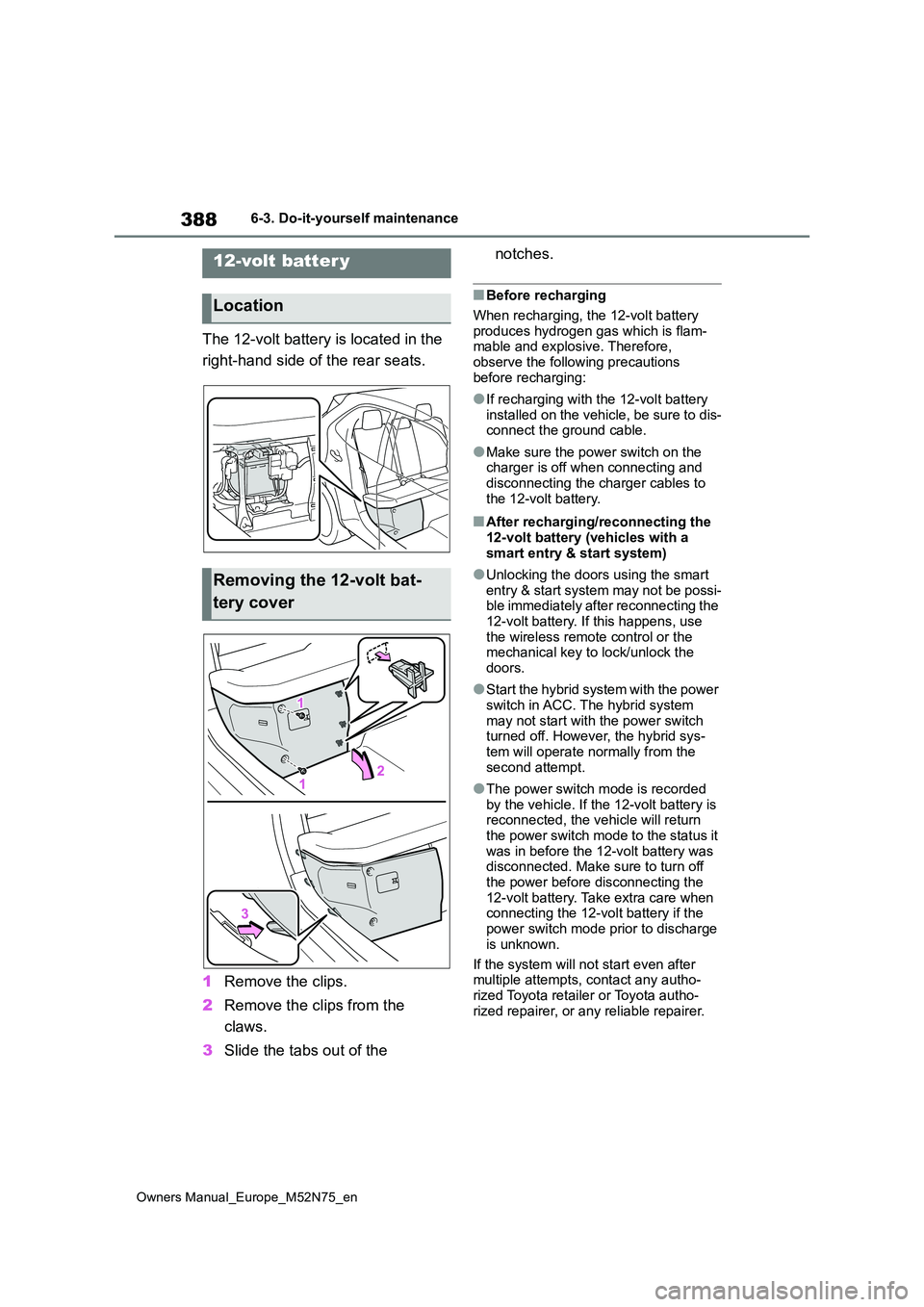
388
Owners Manual_Europe_M52N75_en
6-3. Do-it-yourself maintenance
The 12-volt battery is located in the
right-hand side of the rear seats.
1 Remove the clips.
2 Remove the clips from the
claws.
3 Slide the tabs out of the
notches.
■Before recharging
When recharging, the 12-volt battery produces hydrogen gas which is flam-mable and explosive. Therefore,
observe the following precautions before recharging:
●If recharging with the 12-volt battery installed on the vehicle, be sure to dis-connect the ground cable.
●Make sure the power switch on the charger is off when connecting and
disconnecting the charger cables to the 12-volt battery.
■After recharging/reconnecting the 12-volt battery (vehicles with a
smart entry & start system)
●Unlocking the doors using the smart
entry & start system may not be possi- ble immediately after reconnecting the 12-volt battery. If this happens, use
the wireless remote control or the mechanical key to lock/unlock the doors.
●Start the hybrid system with the power switch in ACC. The hybrid system
may not start with the power switch turned off. However, the hybrid sys-tem will operate normally from the
second attempt.
●The power switch mode is recorded
by the vehicle. If the 12-volt battery is reconnected, the vehicle will return the power switch mode to the status it
was in before the 12-volt battery was disconnected. Make sure to turn off the power before disconnecting the
12-volt battery. Take extra care when connecting the 12-volt battery if the power switch mode prior to discharge
is unknown.
If the system will not start even after multiple attempts, contact any autho-
rized Toyota retailer or Toyota autho- rized repairer, or any reliable repairer.
12-volt batter y
Location
Removing the 12-volt bat-
tery cover